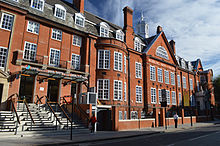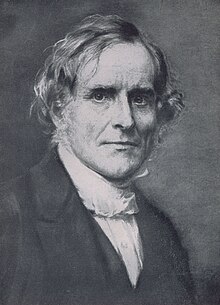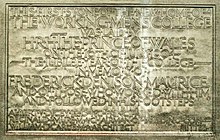Working Men's College
 | |
| Motto | Auspicium Melioris Aevi |
|---|---|
| Type | Specialist college of adult Education[1] |
| Established | 1854 |
| Principal | Dipa Ganguli OBE [2] |
Administrative staff | 125 |
| Students | 4,100 (2018)[1] |
| Location | , , 51°32′07″N 00°08′10″W / 51.53528°N 0.13611°W |
| Website | www |
The Working Men's College (also known as the St Pancras Working Men's College, WMC, or The Camden College), is among the earliest
History and background

Founded in 1854 the college was established in
The college's founders – a view reached in 1904
In the 1870s the new college failed to take up an offer to merge with the Working Women's College which had been founded by Elizabeth Malleson. Malleson decided to make her college co-educational and this caused a dispute amongst her organisation. As a result, F. D. Maurice with Frances Martin helped to set up the College for Working Women in Fitzroy Street in 1874. The minority who supported this college included George and Amelia Tansley, Llewellyn Davies, and Sir John Lubbock. The college was called the Frances Martin College[9] in 1922 after Frances Martin left it a bequest of £500 in her will.[10] This sister college, through financial and organisational difficulties, eventually ran its courses for women at The Working Men's College, and later this in name only as it, and its associated charity, had become unviable. The college's charitable funds were absorbed into those of The Working Men's College, and The Frances Martin College ceased to exist after 90 years in 1967. Around this time, in 1965, The Working Men's College admitted female students for the first time.
The decision to admit women was an expression of what was seen by the college as its unique and progressive historic feature: educational and financial management through a democratically elected Council of teachers and students.[4] Teachers, (who were unpaid volunteer professionals in their field,) and students were both considered as, and called, Members of College as a mark of equality and respect. This educational and management tradition, seen as being in the spirit of a liberal education that promotes values and responsible civic behaviour, and being a direct link to the founders' concern over the failure of Associationism, lasted until the mid-1990s. Sir Wilfred Griffin Eady, principal of the college from 1949 to 1955, defined Liberal Education, the raison d'etre of the college, as "something you can enjoy for its own sake, something which is a personal possession and an inward enrichment, and something which teaches a sense of values".[4]
During the 1970s the college introduced and increased a number of
In 1996–97, the governance of the college was changed. Before the change, two bodies regulated college under
College building and use
1904–2000

The college opened at 31

The Working Men's College
This first stone of the new home of The Working Men’s College was laid by H.R.H. The Prince of Wales on 16th July 1904 The
William D. CaroeM.A. Architect.
The Prince of Wales mentioned later became
The idea of a new purpose-built College had been expressed in the late 1880s. By the 1890s, the demand for more space through increased student numbers, and competition from other institutions such as Evening Continuation Schools and early Polytechnics, created a need for greater accommodation, and a desire for facilities such as a museum, gymnasium and chemistry laboratory. The college developed a new building at Crowndale Road on a site purchased from Lord Camden; begun in July 1904, and partly occupied in 1905, it was formally opened by Sir William Anson in January 1906.[4]
The physical structure of the building at Crowndale Road was designed to reflect that found within
Principal in providing this experience was The Common Room.
The Maurice Hall, with its
The Museum has changed its use over the years, from schoolroom for
The Gymnasium and The Charles Wright Room, were part of a 1936 building extension, through the demolition of two adjacent College-owned houses, funded by
Post-2000
College building and use programmes reduced original common space and removed some specialist rooms. The Common Room, which ceased to be such in its original sense, was split, one half to house a Centre for Student Affairs for

Curriculum
The college provides daytime, evening, weekend, short and year-long courses for adults. The curriculum follows national or College-defined programmes in art, applied arts, humanities, languages, computing and basic education.
In 2008, college provision was graded as "good" or "outstanding" by Ofsted,[17] and in 2009 it was awarded Beacon Status.[18] The 2013 inspection rated it "outstanding",[17] the first College in London to be rated as such in the new framework for inspection.[according to whom?] By 2018 the college had an Ofsted rating down from outstanding to "Good" overall.[19]
Notable associates
Founders
- John Llewelyn Davies[4][20]
- Lowes Cato Dickinson – drawing teacher[4]
- Frederick James Furnivall – English teacher 1854+[4]
- QC – Principal 1873–1883[4]
- Richard Buckley Litchfield[4]
- John Malcolm Forbes Ludlow[4]
- F. D. Maurice – Principal 1854–1872[4]
- John Westlake – mathematics teacher 1854+[4]
1854–1904
- George Allen– student
- Sheldon Amos – teacher 1860s[4]
- John Sherren Brewer – teacher 1854+, Vice Principal 1869–1872[4]
- Ford Madox Brown – art teacher 1854+
- John Wharlton Bunney – student[21][22]
- Arthur Burgess – student[7]
- Edward Burne-Jones – art teacher 1854+
- Samuel Butler – lecturer 1892
- Joseph Henry Collins – student 1860s
- Ebenezer Cooke – student and teacher[4][23]
- Mordecai Cubitt Cooke - teacher
- Albert DiceyKC – Principal 1899–1912
- John Philipps Emslie – student[4]
- Caradoc Evans – student[24]
- Thomas Charles Farrer – student[25][26]
- Frank Wallace Galton – student[27]
- PC – teacher[4]
- Frederic Harrison – teacher 1857[4]
- George Holyoake – teacher 1858+
- Thomas Henry Huxley – lecturer 1880s[4]
- John Lubbock – Principal 1883–1899
- GCMG – teacher, benefactor, Member of Corporation 1858+[4]
- Vernon Lushington QC – teacher 1858+[4][29]
- William Morris – lectures[30]
- Arthur Munby – Latin teacher
- Alexander Munro – art teacher 1854+[4][31]
- PC– Latin teacher 1880s
- Francis Penrose – teacher 1854+[4]
- Frederick Pollock – Member of Corporation 1880s[4]
- Valentine Cameron Prinsep – art teacher 1854+[4]
- Dante Gabriel Rossetti – art teacher 1854–1858
- John Ruskin: art teacher 1854–1858, Member of College Council
- John Robert Seeley – teacher 1860s, Member of Corporation 1880s[4]
- James Fitzjames Stephen – teacher 1855[4]
- Leslie Stephen – lecturer 1854+, Member of Corporation 1880s[4]
- Thomas Sulman – student[32][33][34]
- Richard Chenevix Trench – teacher 1860s[4]
- G. M. Trevelyan – teacher[4]
- John Tyndall – lecturer 1880s[4]
- Thomas Woolner – art teacher 1854+[4]
- John Wharlton Bunney – art student and employee of Ruskin 1854 to 1859[4]
1905–1954
- A L Bacharach, who ran the Sunday Chamber Music Society Concerts for 20 years.
- Ralph George Scott Bankes – benefactor and teacher 1923–1948[4][35]
- Frank Beswick – student
- Wilfred Griffin Eady GCMG, KCB, KBE – Principal 1944–1955
- OBE– Vice Principal, teacher of "electricity"
- Stanley Arthur Franklin – student[36]
- CBE – art teacher 1930s[37]
- George Peabody Gooch – teacher and lecturer[4]
- Wilfred Arthur Greene – Principal 1936–1944[38]
- Percy Horton MA, RBA, ARCA – art teacher 1930s[37]
- Ronald Horton ARCA – art teacher 1929–1932[39]
- Albert Houthuesen – art teacher 1930s[37][40]
- FRSA– Director of Art Classes 1926–1938
- Charles Prestwood Lucas – KCB KCMG – Principal, 1912–1922
- Frederick Barton Maurice– Principal 1922–1933
- George Orwell – teacher
- Geoffrey Rhoades – art teacher 1930s[37][41]
- Vaughan Williams – music teacher[42]
- Arnold Wilson KCIE, CSI, CMG DSO – Principal, 1933–1936
1955–2020
- Ronald Forbes Adam– Principal 1956–1961
- John Bowstead – art teacher
- Henry John Byrt QC – Principal 1982–1987
- Edward DuCann – teacher[42]
- Satnam Gill OBE – Principal (current at 2011)
- Lucy de Groot CBE – Vice Chair of Board
- John Michael Hancock Prof. – Chair of Corporation and Board 1987–1999
- Seamus Heaney – teacher
- Timothy Hyman – art history teacher
- Sarah Lucas – student
- Andrew McIntosh– Principal 1988–1997
- Albert Alan Owen – Dean of Studies, music teacher[43][44]
- Jeremy Seabrook – teacher[45]
- Tom Schuller Prof. – Chair of Board 2008[46][47]
- Ruth Silver DBE – Chair of Board 2002–2005
- Lucius P. Thompson-McCausland – Principal 1969–1979
- Janet Whitaker – Chair of Board 1999–2002
Vice Principals
A principal provided the intellectual driving force and public face of the college. In 1869 F. D. Maurice found his work beyond the college precluded taking as active a role as previously. He recommended an office of Vice Principal to oversee and direct administration. This office was supplemented by others: Dean of Studies, Bursar, and Librarian; all being taken by teachers or students through election. These offices ceased to exist in 1996/97.
|
|
References
- ^ a b "Further education and skills inspection report: The Working Men's College". Office for Standards in Education, Children's Services and Skills. Retrieved 7 January 2021.
- ^ "New Principal Appointed". WM College. June 2023. Retrieved 27 October 2023.
- ^ "Centres and Locations". Archived from the original on 7 January 2021. Retrieved 5 January 2021.
- ^ a b c d e f g h i j k l m n o p q r s t u v w x y z aa ab ac ad ae af ag ah ai aj ak J. F. C. Harrison, A History of the Working Men's College (1854–1954), Routledge Kegan Paul, 1954
- ^ Lowes Dickinson Award 2009[permanent dead link], accessed January 2010
- ^ Lowes Cato Dickinson Archived 6 June 2011 at the Wayback Machine, National Portrait Gallery, accessed January 2010
- ^ ISBN 1406847089
- ^ Charles Blachford Mansfield Archived 17 July 2011 at the Wayback Machine Retrieved 21 January 2011.
- ^ Working Women's College Archived 3 October 2015 at the Wayback Machine, Bloomsbury Project, Retrieved 28 July 2015
- required.)
- ^ The Independent: Lucy Ward Education Correspondent 23 Jan 1997 Archived 25 September 2015 at the Wayback Machine Retrieved 18 January 2011.
- ^ The Oval Room at Great Ormond Street Archived 23 November 2015 at the Wayback Machine Retrieved 18 January 2011.
- ^ The Library at Great Ormond Street Archived 9 November 2015 at the Wayback Machine Retrieved 18 January 2011.
- ^ "The Library at Crowndale Road". 18 July 2010. Archived from the original on 2 September 2021. Retrieved 20 January 2017.
- ^ The Common Room at Crowndale Road Archived 1 June 2016 at the Wayback Machine Retrieved 18 January 2011.
- ^ Davies, J. Llewelyn (1904) The Working Men’s College 1854–1904, Macmillan and Co. p.199; retrieved 2011
- ^ a b "The Working Men’s College" Archived 16 November 2013 at the Wayback Machine, Ofsted inspection reports 2008, 2013. Retrieved 16 June 2013.
- ^ "Specialist Providers" Archived 2 October 2013 at the Wayback Machine, LSIS – Beacon status. Retrieved 30 July 2009.
- ^ "The Working Men’s College", Ofsted 21 December 2018. Retrieved 12 January 2022
- ^ "Death of Mr. Llewelyn Davies" The Times 19 May 1916; retrieved 22 May 2011
- ^ "The Eighth Lamp". Archived from the original on 11 April 2010.
- ^ John Wharlton Bunney biography Archived 6 October 2011 at the Wayback Machine Retrieved 18 January 2011.
- ^ "Ebenezer Cooke". Archived from the original on 27 September 2011. Retrieved 4 September 2009.
- ^ Evans, Caracoc Archived 31 December 2020 at the Wayback Machine The National Library of Wales; retrieved 18 January 2011
- ^ Archives askart.com; retrieved 24 May 2011
- ^ Thomas Charles Farrer Archived 20 October 2012 at the Wayback Machine askart.com; retrieved 24 May 2011
- ^ "Mr. F.W. Galton", The Times, 12 April 1952, p. 8.
- ^ Vernon Lushington: The Rossetti Archive Retrieved 18 January 2011.
- ^ Faulkner, Peter Morris and the Working Men's College Archived 21 December 2016 at the Wayback Machine Morris Society; retrieved 23 May 2011
- ^ Alexander Munro (1825–71): The Victorian Web Archived 20 June 2010 at the Wayback Machine Retrieved 18 January 2011.
- ^ Thomas Sulman: The Rossetti Archive – Mary in the House of St. John Retrieved 18 January 2011
- ^ Thomas Sulman: The Rossetti Archive – Two Lovers Embracing Retrieved 18 January 2011
- ^ Thomas Sulman: The Rossetti Archive – Jan Van Eyck's Studio Retrieved 18 January 2011
- ^ Ralph George Scott Bankes: Twyford School Archived 24 February 2014 at the Wayback Machine Retrieved 18 January 2011
- ^ Stanley Arthur Franklin: British Cartoon Archive Archived 2 March 2010 at the Wayback Machine Retrieved 18 January 2011
- ^ ISBN 0-900660-85-6
- ^ Wilfred Arthur Greene: Oxford Dictionary of National Biography Archived 2 December 2008 at the Wayback Machine Retrieved 18 January 2011
- ^ Ronald Horton Archived 18 October 2012 at the Wayback Machine National Archives; retrieved 22 May 2011
- ^ Albert Houthuesen Archived 12 July 2011 at the Wayback Machine; retrieved 21 May 2011
- ^ Geoffrey Rhoades Archived 11 July 2011 at the Wayback Machine The Tate Collection; retrieved 21 May 2011
- ^ a b The Working Men's College Archived 26 January 2013 at the Wayback Machine aaowen.com; retrieved 24 May 2011
- ^ Randle, Lawrence (1990). Daytime and Evening Courses 1990/1991 Prospectus (First ed.). Working Men's College. p. 2.
- ^ "Aberystwyth Arts Centre". Archived from the original on 21 July 2012. Retrieved 15 September 2020.
- ^ Jeremy Seabrook Profile Archived 3 January 2017 at the Wayback Machine Guardian; retrieved 24 May 2011
- ^ Tom Schuller: OECD Directorate for Education Archived 2 September 2021 at the Wayback Machine Retrieved 18 January 2011
- ^ Tom Schuller: Pascal International Observatory Archived 21 September 2018 at the Wayback Machine; retrieved 18 January 2011
External links
 Media related to Working Men's College at Wikimedia Commons
Media related to Working Men's College at Wikimedia Commons- Working Men’s College, UCL Bloomsbury Project. Retrieved 4 August 2015
- Official website
